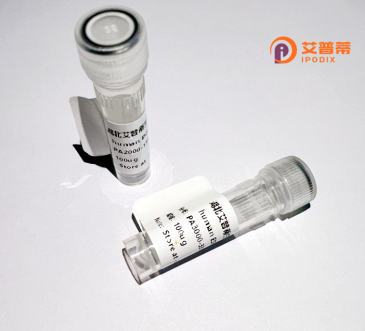
| 纯度 | >90%SDS-PAGE. |
| 种属 | Human |
| 靶点 | INSC |
| Uniprot No | Q1MX18 |
| 内毒素 | < 0.01EU/μg |
| 表达宿主 | E.coli |
| 表达区间 | 1-579aa |
| 活性数据 | MRRPPGNGEAASEGPGGWGLWGVQESRRLCCAGHDRCKQALLQIGINMMALPGGRHLDSVTLPGQRLHLMQVDSVQRWMEDLKLMTECECMCVLQAKPISLEEDAQGDLILAGGPGPGDPLQLLLKRGWVISTELRRIGQKLAQDRWARVHSMSVRLTCHARSMVSEYSAVSRNSLKEMGEIEKLLMEKCSELSAVTERCLQVENEHVLKSMKACVSETLSMLGQHFGQLLELALTREVQALVRKIDASDNIYTTESTTGNLFSLTQEGAPLCRIIAKEGGVVALFKVCRQDSFRCLYPQALRTLASICCVEEGVHQLEKVDGVLCLADILTDNSHSEATRAEAAAVVAQVTSPHLPVTQHLSSFLESMEEIVTALVKLCQEASSGEVFLLASAALANITFFDTMACEMLLQLNAIRVLLEACSDKQRVDTPYTRDQIVTILANMSVLEQCASDIIQENGVQLIMGMLSEKPRSGTPAEVAACERVQQKAAVTLARLSRDPDVAREAVRLSCMSRLIELCRSPSERNSSDAVLVACLAALRRLAGVCPEGLQDSDFQQLVQPRLVDSFLLCSNMEESFV |
| 分子量 | 63.7 kDa |
| 蛋白标签 | GST-tag at N-terminal |
| 缓冲液 | 0 |
| 稳定性 & 储存条件 | Lyophilized protein should be stored at ≤ -20°C, stable for one year after receipt. Reconstituted protein solution can be stored at 2-8°C for 2-7 days. Aliquots of reconstituted samples are stable at ≤ -20°C for 3 months. |
| 复溶 | Always centrifuge tubes before opening.Do not mix by vortex or pipetting. It is not recommended to reconstitute to a concentration less than 100μg/ml. Dissolve the lyophilized protein in distilled water. Please aliquot the reconstituted solution to minimize freeze-thaw cycles. |
1. **《Production of recombinant human insulin in Escherichia coli》**
*作者:Goeddel DV, Kleid DG, Bolivar F*
摘要:该文献描述了利用大肠杆菌表达系统首次成功生产重组人胰岛素的方法,通过基因克隆技术将人胰岛素原基因导入E. coli并优化表达条件,为工业化生产奠定了基础。
2. **《High-level expression of recombinant human proinsulin in the methylotrophic yeast Pichia pastoris》**
*作者:Li Y, Wei H, Yang J*
摘要:研究报道了在毕赤酵母中高效表达重组人胰岛素前体的策略,通过优化启动子和发酵条件,显著提高产量并降低杂质,为大规模生物制药提供参考。
3. **《A novel approach for purification of recombinant human insulin-like growth factor-I》**
*作者:Kjeldsen T, Brandt J, Andersen AS*
摘要:文章提出一种基于亲和层析的新方法,用于从重组表达体系中高效纯化具有生物活性的人胰岛素类似物,验证了其结构与功能接近天然胰岛素。
4. **《Stabilization of recombinant human insulin formulations by excipient selection》**
*作者:Patil R, Burgess DJ*
摘要:探讨了不同稳定剂对重组人胰岛素液态制剂长期保存的影响,发现特定赋形剂组合可有效抑制聚集变性,提升药物货架期。
Recombinant human INSC protein is a genetically engineered form of the human Inscuteable (INSC) protein, a key regulator of asymmetric cell division and cellular polarity during neurodevelopment. INSC plays a critical role in coordinating mitotic spindle orientation and cell fate determination, particularly in neural progenitor cells. Dysregulation of INSC has been linked to neurodevelopmental disorders and cancer, highlighting its biological significance. The recombinant version is produced using expression systems like *E. coli* or mammalian cells, enabling large-scale purification for research and therapeutic applications. Its production typically involves cloning the *INSC* gene into expression vectors, followed by affinity chromatography and validation via SDS-PAGE or Western blot. Recombinant INSC protein serves as a vital tool for studying molecular mechanisms in neural development, tumorigenesis, and tissue regeneration. Researchers utilize it in cell culture assays, protein interaction studies, and *in vivo* models to explore its role in signaling pathways, such as the Par3/Par6/aPKC complex. Additionally, it holds potential for drug screening to target diseases associated with polarity defects. By providing a pure, functional form of INSC, this recombinant protein accelerates both basic research and translational studies in developmental biology and precision medicine.
×